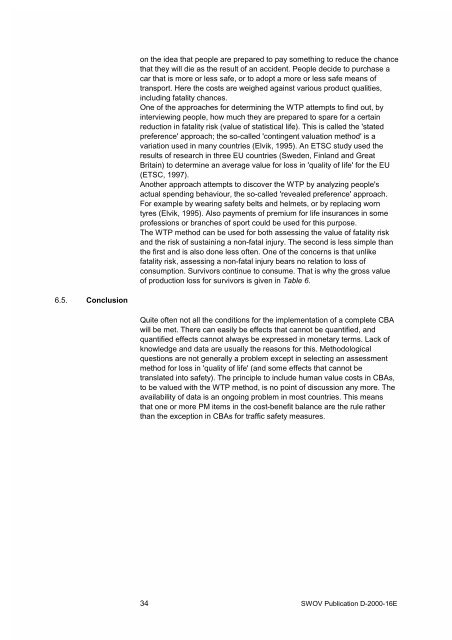Economic evaluation of road safety measures - Swov
Economic evaluation of road safety measures - Swov
Economic evaluation of road safety measures - Swov
Create successful ePaper yourself
Turn your PDF publications into a flip-book with our unique Google optimized e-Paper software.
on the idea that people are prepared to pay something to reduce the chance<br />
that they will die as the result <strong>of</strong> an accident. People decide to purchase a<br />
car that is more or less safe, or to adopt a more or less safe means <strong>of</strong><br />
transport. Here the costs are weighed against various product qualities,<br />
including fatality chances.<br />
One <strong>of</strong> the approaches for determining the WTP attempts to find out, by<br />
interviewing people, how much they are prepared to spare for a certain<br />
reduction in fatality risk (value <strong>of</strong> statistical life). This is called the 'stated<br />
preference' approach; the so-called 'contingent valuation method' is a<br />
variation used in many countries (Elvik, 1995). An ETSC study used the<br />
results <strong>of</strong> research in three EU countries (Sweden, Finland and Great<br />
Britain) to determine an average value for loss in 'quality <strong>of</strong> life' for the EU<br />
(ETSC, 1997).<br />
Another approach attempts to discover the WTP by analyzing people's<br />
actual spending behaviour, the so-called 'revealed preference' approach.<br />
For example by wearing <strong>safety</strong> belts and helmets, or by replacing worn<br />
tyres (Elvik, 1995). Also payments <strong>of</strong> premium for life insurances in some<br />
pr<strong>of</strong>essions or branches <strong>of</strong> sport could be used for this purpose.<br />
The WTP method can be used for both assessing the value <strong>of</strong> fatality risk<br />
and the risk <strong>of</strong> sustaining a non-fatal injury. The second is less simple than<br />
the first and is also done less <strong>of</strong>ten. One <strong>of</strong> the concerns is that unlike<br />
fatality risk, assessing a non-fatal injury bears no relation to loss <strong>of</strong><br />
consumption. Survivors continue to consume. That is why the gross value<br />
<strong>of</strong> production loss for survivors is given in Table 6.<br />
6.5. Conclusion<br />
Quite <strong>of</strong>ten not all the conditions for the implementation <strong>of</strong> a complete CBA<br />
will be met. There can easily be effects that cannot be quantified, and<br />
quantified effects cannot always be expressed in monetary terms. Lack <strong>of</strong><br />
knowledge and data are usually the reasons for this. Methodological<br />
questions are not generally a problem except in selecting an assessment<br />
method for loss in 'quality <strong>of</strong> life' (and some effects that cannot be<br />
translated into <strong>safety</strong>). The principle to include human value costs in CBAs,<br />
to be valued with the WTP method, is no point <strong>of</strong> discussion any more. The<br />
availability <strong>of</strong> data is an ongoing problem in most countries. This means<br />
that one or more PM items in the cost-benefit balance are the rule rather<br />
than the exception in CBAs for traffic <strong>safety</strong> <strong>measures</strong>.<br />
34 SWOV Publication D-2000-16E
















